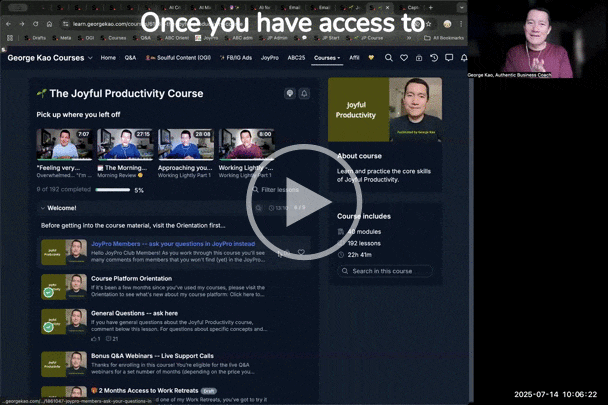- Orientation
- BizPlan
- BizPlan25
- Authentic Speaking
- Authentic Market Discovery
- Create Aligned Offers
- Joyful Productivity (Course)
- ✨ Authentic Outreach (AO)
- Joyful Pro
- Blog-to-Book
- 🚀 Course Creators
- 🖼️ Your Signature Framework
- 🙋 Effortless Yes
- 🌈 Energy Signature
- Meta Ads (FB / IG Advertising)
- 📱 Instagram Mastery
- 🎤️ Interview Mastery
- Launch Your Group Program
- Netcaring
- 🦸🏽✍🏽 Soulful Content (OGI)
- Substack Course
- "What do you do?"
- 🎬 YouTube Mastery

Hi All!
I'm grateful to be able to teach courses and run group programs to help people grow their authentic business and joyful productivity.
My social media links:
Instagram: https://www.instagram.com/geokao
Youtube: https://www.youtube.com/georgekao
LinkedIn: https://www.linkedin.com/company/georgekao
Facebook: https://www.Facebook.com/GeorgeKaoCommunity
Twitter: https://twitter.com/georgekao
Medium: https://georgekao.medium.com
- Everything
- Excluding groups
- Soul Gym Content Creation
- ABC 2023
- 2024 ABC Masterheart
 8:55
8:55
Why "watch" my courses? Simply chat with it -- get AI to be your personal tutor :)
You can save tons of time -- and make my course material personally applicable to you -- by chatting with the Ai bot that's connected to any of my courses :) The above video shows you how!
- Summarize this thread
- Copy link
Got value out of the CCC method.
I don't like how when you pause the video then resume, it kind of makes the video transparent for a second or two before it becomes clear and visible again. I would recommend the videos to display full opacity all the time even after pausing and resuming.
However, this chatbot feature is amazing because it saves me a lot of time and hassle.
- Summarize this thread
- Copy link
@Allan Chiang thanks for letting me know about that video transparency issue. I'll look into it!
 4:26
4:26
Who "should" be creating courses? Don't we need an audience first?
"What if this is my first offering as a creator? Should people just entering the content creation field start elsewhere?" This is a fantastic question that many aspiring course creators grapple with. The short answer is: No, you don't need a large, established audience to successfully create and launch a course. In fact, creating a well-crafted course can be one of the fastest ways to build your audience and establish yourself as an expert in your field. The Power of Courses for New Creators: The beauty of courses, especially shorter courses or even a single, well-focused webinar, lies in their ability to: Showcase Your Expertise: A course allows you to demonstrate your knowledge and passion in a structured, in-depth way that goes far beyond a blog post or social media update. It positions you as a go-to resource. Provide Tangible Value: Students are actively seeking solutions and transformation. A well-designed course offers that, making it inherently valuable and attractive. Accelerate Audience Growth: When your course is aligned with what people want and need, and it's delivered well, it can be a highly effective tool for word-of-mouth audience growth. Build Authority Quickly: Successfully teaching a course, even a small one, establishes credibility and positions you as an authority in your niche. My Personal Story and Strategy: I (George Kao) actually started my online business by creating courses right from the start. I didn't have a large following. Here's the strategy I used, and it's one you can adapt, starting with the people you already know: Identify Your Expertise & Passion: What are you genuinely knowledgeable and passionate about? What problems can you solve for others? This is the foundation of your courses. Identify "Influencers" (Within Your Network): Look at the people already in your network. This includes: Facebook friends LinkedIn connections People who follow you on Instagram (or other social media) Contacts in your cell phone address book Email contacts People you've met at networking events or conferences Colleagues past and present Clients past and present Are there friends, colleagues, or acquaintances who have a network or audience that would benefit from your course topic? These could be bloggers, authors, podcasters, service providers, other course creators with a complementary offering, or even just individuals with a bit of a following. Think broadly – "influence" doesn't always mean having a massive following. It can mean having a small but highly relevant following. Offer Genuine Help: Approach these individuals and offer to help them personally (for free) with the topic of your course. This isn't a sales pitch; it's a genuine offer of value, leveraging your existing connection. You might say something like, "Hey [Name], I know you're interested in [Topic]. I've been developing some expertise in this area, and I'd love to offer you a free consultation/mini-training/resource to help you with [Specific Problem]." Build (or Strengthen) Relationships: By providing valuable assistance, you build (or deepen) trust and rapport with these individuals. Strategic Collaboration: After you've provided value and established a stronger connection, you can then explore the possibility of them sharing your course with their audience. This is much more effective than a cold outreach because it's built on a foundation of genuine help and a pre-existing relationship. Key Takeaway: Don't let the lack of a large audience hold you back. A well-crafted course, combined with a strategic approach to leveraging your existing network, can be a powerful engine for growth. We will be diving a lot more deeply into the above strategy, and working on the specifics, in the coming modules of this course. Revisiting Lesson 1: Think back to the qualities of an effective course creator we discussed in Lesson 1. Do you want to embody those qualities more fully? If so, creating courses is not just a business strategy; it's a path to personal and professional development. Action Step: Start brainstorming a list of people in your existing network who might be a good fit for the "influencer" strategy described above. Consider who has a relevant audience and who you could genuinely help. Comment below on whether you have ever thought of this strategy, or how you might now use it. Also comment on any connections that came to mind!
- Summarize this thread
- Copy link
I have a course I am offering for the first time. The overarching theme is "Decode your Health, understading your lab results." I do have the credentials for this. How do you suggest I develop an audience first off?
- Summarize this thread
- Copy link
@Debbie Nobles it's an important question -- how to develop an audience for the course -- and you'll see it answered as you continue in the course. It's addressed in Module 1 and 2, and also in Module 5.
 3:55
3:55
Welcome 🤗
Welcome! 😊 I'm so glad you're here. Before we dive into the content, I want you to take a moment to feel the energy of this space... Right now, soulpreneurs just like you are gathered here—coaches, healers, artists, consultants, and heart-centered service providers. Each one is committed to doing work that brings more beauty, meaning, and upliftment to the world. That's what makes this community special. You're not surrounded by people chasing shortcuts or hype. You're alongside people who care deeply about the how of business, not just the results. Take a breath and let that land. ✨ What you'll gain in this module: A simple map of the 5 Levels — so you can see the full landscape of business development for a soulpreneur, and locate yourself on it A clear picture of the 7 Practices — the core ways to grow an authentic business, so you know what's effective to focus on One small experiment — a doable action for the next 7 days that fits where you actually are No overwhelm. Just clarity and one next step :) A note on how we'll work together: This definitely isn't about perfection, or pressure. It's about honest reflection and gentle/sustainable forward movement. I'll share frameworks, but I invite you to feel into what resonates, and always feel welcome to offer your feedback/suggestions in the comments. Your intuition matters here just as much as what's being taught "to" you. Also, as you see fellow soulpreneurs comment, I hope you'll take a moment and reply to 2 others' comments for every one that you create. This keeps a healthy balance in our course community, and your replies will be encouraging for those commenters. Thank you! Let's begin. 🙏🏼🧡
- Summarize this thread
- Copy link
Chats from live participants re: what is a soulpreneur? --
Erich Hunter:
A person who cares about clients and potential clients. Part of your souls calling to do the work and provide business.
Rhya Merrell:
Building a business that aligns with ones true passion and soul work with the hopes to add value and good to the world 🙂
Laura Hudson-Resilient Spirit:
Soulpreneur: Soulcentric practitioner offering services using entrepreneurial tools
Jayni:
Soulpreneur: soul's purpose aligned to one's work in the world.
Lou (she):
For me, Soulpreneur is a business that not only benefits the soul of my clients, but also feeds my soul in a way that the business is not work, it is an offering of service to others.
Adam Langley:
Soulpreneur: An entrepreneur who brings their authentic self into their work and builds a business devoted to nurturing, guiding, and supporting the unfolding of the deeper essence — the values, wisdom, and lived integrity — of their clients.
- Summarize this thread
- Copy link
Oof! FINALLY a coach and a course that actually speaks the truth! That's what i want to start off with. Thank you George.
I have a question to this video: The conundrum I'm dealing with is that
1. I don't think I have 20 people who would be easy to 'convert' as part of a group program.
2. If I', lucky, I might manage (under the current circumstances), to maybe get 3-5. Additionally, the people I am thinking of probably don't even have a budget fo anything more than 25-20 bucks to invest a month into a group program. (ok that's more than 1 conundrum 😅)
What does this expose? is my market discovery too poor? My netcaring? My limiting beliefs? Or an industry-specific issue (musicians and artists struggle with very poor mental hygiene - I know that sounds judgy but 30 + years of empirical research talking here).
And is there a solution you recommend to proceed? Thank you 🙏🏽
- Summarize this thread
- Copy link
@T.L. Mazumdar I love seeing you engage with this course!
Great question, and I think it may be a mix of the factors you named 😆🙏🏼 but I do think that if you move forward with engaging your network in the Market Discovery process, you might find Program ideas that they would love, and willing to pay $100/month for.
- Summarize this thread
- Copy link
@George Kao Thank you for taking the time to reply to these 🙏🏽💜. Would you say launchign a group program with 3.5 people paying a 'no brainer' price like 25-30 bucks is worth the time? I'll proceed with the rest course in in the meantime.
- Summarize this thread
- Copy link
@George Kao Juat saw the next video where you say 'don't proceed with he course before doing the exercise' 😅. Your video's read minds.
 10:47
10:47
- Summarize this thread
- Copy link
LIVE CHATS:
Anyā Likhitha:
I love people / am an extrovert, but I also seem to love observing the world from my corner of the world and just “tossing” the thought out there for whoever to witness if it is right. Somehow it feels like I chose being a solopreneur on some days so I don’t have to talk as much to people 🤣 but business or even using business as a vessel to serve is so relational haha, easy to forget/ easy to be in this corner and let the world go by without talking much because it takes intentional spoons/ energy
Donna Becker:
Netcaring is probably my favorite part of doing my work.
Anyā Likhitha:
Your passion is enthusiastic Donna!! It’s rubbing off on me :’)
Donna Becker:
Here's a theory:
Is it possible that the heart centered business owners are more protective of their capacity, and maybe more prone to NS dysregulation.
Collaborating takes an outward energy, which often is harder when you are a person who needs to do more selfcare, inner energy work.
Anyā Likhitha:
Resonating with this, takes me time to step back into my own presence and energy after being with people

Q&A Webinars -- Live Support Calls
Thanks for enrolling in this course! You’re eligible for Q&A webinars for the next 2 months. In these events you can ask me anything, or request my feedback on anything that you're working on. Sign up below: See the dates & sign up for the Q&A calls It's optional, and even if you don't sign up, you'll get those recordings emailed to you. You can "mark as complete" below to acknowledge knowing about the Q&A calls :)
- Summarize this thread
- Copy link
I'm stoked about Q&A calls. And...there are none listed when I click the link above. Thanks!! (This is a boring first comment, oh well.)
- Summarize this thread
- Copy link
@ri dym thank you Ri! You're absolutely right. It wasn't showing up there. But now it is! Go ahead and try refreshing the page: https://www.georgekao.com/qa -- I look forward to seeing you on a call :)
- Summarize this thread
- Copy link
@ri dym oops! There was a mistake and I just now corrected it... so the events are now showing up -- https://www.georgekao.com/qa
- Summarize this thread
- Copy link
@George Kao Hi George, thank you!! Sorry for delayed reply — I was taking a few days camping with all the devices turned off. (Whew, that was nice.) Back now, catching up on your videos. Looking forward to a live Q&A soon.




I’ll definitely play around with this, I like that it can reply and assess my personal situation in particular ⭐️
AND I don’t think it’s a waste of time to watch your videos. First, I can speed them up (I like that Simplero allows that easily) if the content is light, or slow it down if it’s a complex topic and I need space. Also I can just listen in the background as I do chores or walk!. 😅
@Jennifer Kogut thank you! I look forward to hearing how it goes when you try the feature.